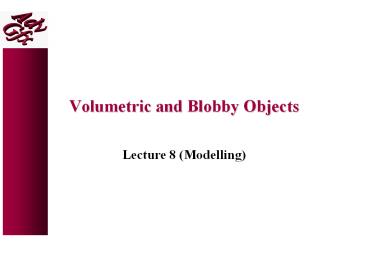Volumetric and Blobby Objects - PowerPoint PPT Presentation
Title:
Volumetric and Blobby Objects
Description:
Cell vertices (hence some topology and geometry) are shared between cells. ... Isosurface extraction (e.g. marching cubes) is used to find this boundary. ... – PowerPoint PPT presentation
Number of Views:239
Avg rating:3.0/5.0
Title: Volumetric and Blobby Objects
1
Volumetric and Blobby Objects
- Lecture 8 (Modelling)
2
Isometric Data
- Medical Scans (CT, MRI) produce image slices with
a regular grid of sample values (for skin, bone,
muscle, etc). - The isosurface at a particular isovalue is very
difficult to visualize from separate 2D scans. - Solution convert to a 3D surface.
- Isosurface Extraction Methods
- Voxels an intermediate volumetric
representation. - Ray Casting direct rendering for ray tracing.
- Marching Cubes convert to a polygon mesh.
3
Voxels
- Spatial Occupancy Enumeration
- solid is decomposed into identical cells arranged
in a rectangular grid. - Elements are generally cubes, called voxels
(volume elements). - Scan to Voxel Conversion
- If image slices are stacked into pairs then
voxels can be created with image sample values at
the corners. - A voxel is given the value 1 (solid) if all
sample values are greater than the iso-value and
0 (transparent) otherwise. - Problems
- Aliasing and high storage costs.
- Still requires conversion to polygon-mesh for
rendering. - Solutions 3D anti-aliasing and octree data
structure.
4
Voxels Octree Data Structure
- Octree
- A compact hierarchical encoding of a voxmap
(voxel map). - The 3D generalization of a quadtree.
- Leaves represent full or empty voxels of
different volumes. The voxel dimensions depend on
its depth in the tree. - Can merge same value voxels into a single larger
voxel.
5
Marching Cubes
- Purpose convert 2D isometric scans into a
polygon mesh isosurface for a particular isovalue
. - Algorithm
- Pair up scans. Create cubes (cells) with sample
values at the vertices (4 from the upper scan, 4
from the lower scan). - March over all cubes
- Topology Place triangles in a cube depending on
the isovalues at the cell vertices. - Geometry position the vertices of these
triangles according to the isovalues. - For efficiency exploit inter-cell coherence. Cell
vertices (hence some topology and geometry) are
shared between cells. - Seminal Paper Lorensen, W. and Cline, H.
Marching Cubes A High Resolution 3D Surface
Construction Algorithm, SIGGRAPH 87, pp.
163-169.
6
Marching Cubes Triangulating a Cell
- Binary coding A vertex with value
is inside (1) or outside (0) as
follows - The binary codes for all vertices are
placed in a bit string used as an index
into the
triangulation table. - There are combinations.
- But
- Complementary cases inverting the
cell bits does not change
triangulation
(reduce to 148 combinations). - Rotational symmetry many patterns
can be reached by rotating the cube
(reduce to 14 unique combinations).
7
Marching Cubes Positioning Vertices
- Triangulated cells have triangle vertices placed
along cell edges. - The exact position and normal of these vertices
must depend on the cell values. - Solution Triangle vertices are positioned at
along an edge using linear interpolation - where is the value at the cell vertex inside
the isosurface, and is the external vertex
value. - Normals can be similarly interpolated.
- More sophisticated interpolation is possible.
8
Blobby Objects
- Blobby (or Soft) objects are employed in the
creation and animation of smooth shapes. - Use implicit rather then
parametric surfaces. - A skeleton is defined by a set of key points,
which radiate energy to the surrounding space. - The object boundary is an isosurface at a
particular energy level. - Isosurface extraction (e.g. marching cubes) is
used to find this boundary. - The position and orientation of keys can be
animated. - Animation control is easier than for parametric
surfaces. - Other blobby parameters are amenable to
animation.
9
Blobby Objects Parameters
- Blobby objects consist of a number of keys, each
with - A position of the key in 3D.
- An optional set of axes to orient the blob.
- An implicit field function , which
determines the shape of the blob. depends
on and . Superellipsoids are popular. - Force at the key . Often set to
(merges with other blobs) or (creates
imprints on other blobs). - A Decay function , which defines how
intensity tails off from the key towards the blob
boundary.
10
Blobby Objects Field Calculation
- Given a point , the field contribution from a
key is calculated as follows - Find .
- Calculate the distance where the field
value turns to zero along the line by
solving the field function . - If then the keys contribution is
zero. Otherwise, the field value at is
(force times decay). - A popular decay function is
. - Repeat and sum the field
value for all keys.
11
Blobby Objects Examples































